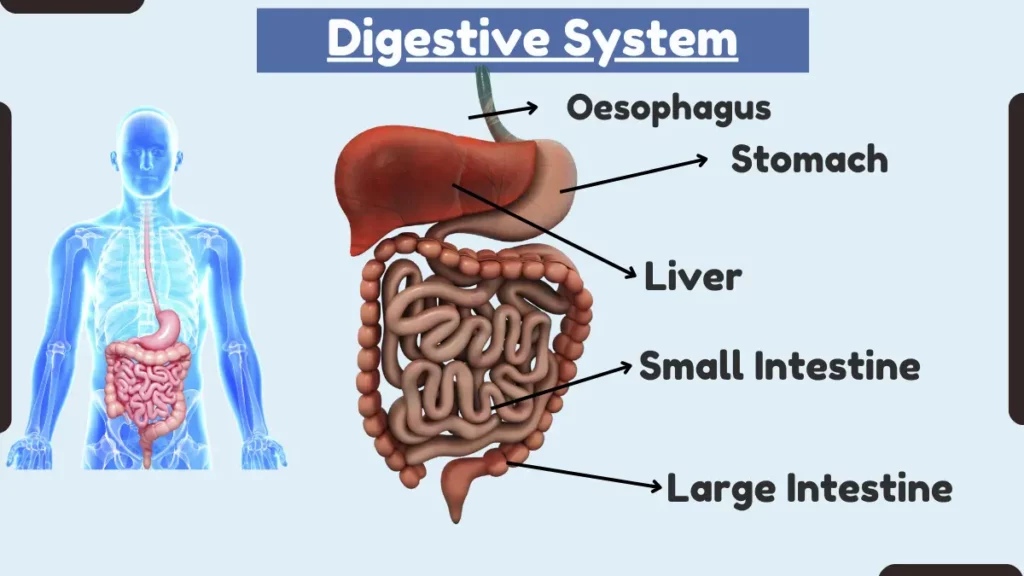Digestive System – Anatomy, Types, and Functions
The digestive system is a complex network of organs and structures that work together to break down food into nutrients that can be absorbed and used for energy, growth, and repair.

Types of Digestive System
The four basic types of digestive systems in animals are:
1. Monogastric
Animals with a monogastric digestive system have a simple stomach with one chamber. Examples of monogastric animals include humans, pigs, dogs, and cats.
Monogastric animals, such as swine, typically eat rations high in concentrates. Concentrates are feeds that are high in energy and nutrients, such as grains and legumes. Monogastric animals are able to digest concentrates efficiently because they have a simple stomach and short digestive tract.
2. Avian
The avian digestive system is found in birds. It is similar to the monogastric digestive system, but it has some unique features, such as a gizzard, which helps to grind up food.
The avian digestive system is completely different from the other three types of digestive systems. Birds have a gizzard, which is a muscular organ that helps to grind up food. Birds also have a cloaca, which is a single opening for waste elimination and reproduction.
3. Ruminant
Ruminant animals have a four-chambered stomach. This allows them to digest plant material, which is difficult to digest for other animals. Examples of ruminant animals include cows, sheep, and goats.
Ruminant animals have a four-chambered stomach that allows them to digest plant material. The first two chambers of the stomach, the rumen and reticulum, contain microbes that help to break down cellulose, the main component of plant cell walls.
The third chamber of the stomach, omasum absorbs water from the food. The fourth chamber of the stomach, the abomasum, is similar to the human stomach and contains digestive enzymes that break down proteins, fats, and carbohydrates.
4. Pseudo-ruminant
Pseudo-ruminant animals have a three-chambered stomach and a large cecum. This allows them to digest plant material, but not as efficiently as ruminant animals. Examples of pseudo-ruminant animals include horses, rabbits, and guinea pigs.
Pseudo-ruminant animals have a three-chambered stomach and a large cecum. The cecum is a pouch located at the junction of the small and large intestines. It contains microbes that help to break down plant material. Pseudo-ruminant animals are not as efficient at digesting plant material as ruminant animals, but they are still able to get the nutrients they need from plants.
Also Read: What is Anatomy?
Anatomy of the Digestive System
The human digestive system is made up of two main parts:
- Alimentary canal (gastrointestinal tract): This long tube runs from the mouth to the anus and includes the mouth, pharynx, esophagus, stomach, small intestine, and large intestine (colon).
- Accessory organs: These organs assist in the digestive process but are not part of the alimentary canal. They include the liver, gallbladder, and pancreas.
Digestive System Parts
Here are parts of digestive system:
1. Mouth
The mouth is where digestion begins. Food is broken down into smaller pieces by chewing and mixed with saliva, which contains enzymes that start to break down carbohydrates.
2. Pharynx and esophagus
After chewing and swallowing, food travels through the pharynx and esophagus, which transport it to the stomach by muscular contractions.
3. Stomach
In the stomach, food is mixed with gastric juices containing acids and enzymes that further break down proteins.
4. Small intestine
The small intestine is where most of the digestion and nutrient absorption occurs. It is divided into three parts: the duodenum, jejunum, and ileum. Enzymes from the pancreas and bile from the liver and gallbladder aid in digestion here.
5. Large intestine (colon)
The large intestine absorbs water and electrolytes from the remaining undigested food, forming feces for elimination.
Digestive System Organs
The following organs coordinate with each other to make up the digestive system.
1. Liver
The liver plays a crucial role in metabolism and detoxification. It produces bile, which is stored in the gallbladder and released into the small intestine to aid in the digestion of fats.
2. Gallbladder
The gallbladder stores and concentrates bile produced by the liver. When needed, it releases bile into the small intestine to emulsify fats (break them down into smaller droplets).
3. Pancreas
The pancreas secretes digestive enzymes (lipases, proteases, and amylases) into the small intestine, further aiding in the breakdown of nutrients.
Functions of the Digestive System
The digestive system has several important functions:
- Ingestion: Taking in food through the mouth.
- Digestion: Breaking down food into smaller molecules through mechanical and chemical processes.
- Absorption: The small intestine absorbs nutrients, vitamins, and minerals into the bloodstream.
- Transportation: Muscular contractions move food and waste materials through the digestive tract.
- Elimination: The large intestine eliminates undigested food as feces.
How Does the Digestive System Work?
Here is a simplified overview of the digestive process:
- Food enters the mouth and is broken down into smaller pieces by chewing.
- Saliva mixes with the food and starts to break down carbohydrates.
- The food is swallowed and travels down the esophagus to the stomach.
- In the stomach, food is mixed with gastric juices containing acids and enzymes that further break down proteins.
- The food is then broken down further by enzymes from the pancreas and bile from the liver and gallbladder in the small intestine.
- Nutrients are absorbed into the bloodstream from the small intestine.
- Undigested food passes into the large intestine, where water and electrolytes are absorbed, and feces are formed.
- Feces are eliminated through the anus.

 written by
written by 

Leave a Reply